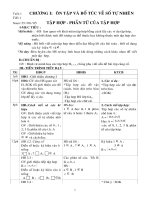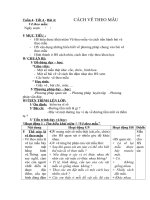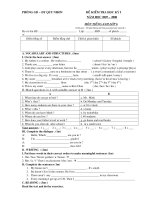California science vocabulary card(1 6) (4)
Bạn đang xem bản rút gọn của tài liệu. Xem và tải ngay bản đầy đủ của tài liệu tại đây (6.53 MB, 166 trang )
Photograph by Frank Lane Picture Agency/Corbis
Grade 4
Published by Macmillan/McGraw-Hill, of McGraw-Hill Education, a division of The McGraw-Hill Companies, Inc.,
Two Penn Plaza, New York, New York 10121.
Copyright © by Macmillan/McGraw-Hill. All rights reserved. No part of this publication may be reproduced or distributed in
any form or by any means, or stored in a database or retrieval system, without the prior written consent of The McGraw-Hill
Companies, Inc., including, but not limited to, network storage or transmission, or broadcast for distance learning.
1 2 3 4 5 6 7 8 9 063 09 08 07 06
ISBN 13: 978-0-02-286134-6
ISBN 10: 0-02-286134-3
Vocabulary Cards
Vocabulary Cards help build word knowledge and
understanding of Science Glossary terms by:
• providing an opportunity for vocabulary preview,
review, and reinforcement
• fostering language development skills
• supporting the acquisition of academic language for
English learners
Vocabulary Cards can be placed in your classroom
Science Center.
abiotic factor
(āªbī otºik
fakºtәr)
© Macmillan/McGraw-Hill
Grade 4
Photograph by © Purestock/Superstock
Photograph by © AGE Fotostock/Superstock
© Macmillan/McGraw-Hill
Grade 4
(ә brāºzhәn)
abrasion
Vocabulary Routine
Define: A nonliving part of the ecosystem.
Example: Hot temperatures and rainfall are abiotic
factors in the desert ecosystem.
Ask: How does a change in the abiotic factors in
an environment affect the animals that live
there?
Ask: What does wind carry that casuses abrasion
to form shapes in rocks?
Example: Wind abrasion is a form of physical
weathering that wears down rock.
Define: The peeling or scraping away of an outer
layer.
Vocabulary Routine
accommodation
(ә käªmә dāºshәn)
© Macmillan/McGraw-Hill
Grade 4
Photograph by © Raymond Gehman/CORBIS
Photograph by © Steve Weston
© Macmillan/McGraw-Hill
(akºtiv vol cāºnō)
active
volcano
Grade 4
Vocabulary Routine
Define: An individual organism’s response to a
change in the ecosystem.
Example: One type of accommodation is a change in
the type of food an organism eats.
Ask: What happens when animals cannot use
accommodation to survive when their food
source suddenly disappears?
Ask: How could a volcano that is not erupting
right now still be considered an active
volcano?
Example: Mt. Saint Helens is an active volcano.
Define: A volcano that still erupts from time to time.
Vocabulary Routine
adaptation
(aªdapªtāºshәn)
© Macmillan/McGraw-Hill
Grade 4
Photograph by © Ron Sanford/CORBIS
Photograph by © Greg Harris
© Macmillan/McGraw-Hill
Grade 4
(alºjē)
algae
Vocabulary Routine
Define: A special trait that helps an organism sur-
vive in its environment.
Example: A fish’s gills are an example of adaptation.
Ask: How is a hummingbird’s beak an example of
an adaptation that helps it get food?
Ask: How do algae act like green plants?
Example: Algae usually float on the surface of ponds
and lakes.
Define: A plant-like producer in a water
environment.
Vocabulary Routine
alternating
current
(ôlºtәr nā ting kûrºәnt)
© Macmillan/McGraw-Hill
Photograph by © Ken Cavanagh/Macmillan-McGraw Hill
Grade 4
Photograph by © M.I. Walker/NHPA
© Macmillan/McGraw-Hill
Grade 4
(әmēº bә)
amoeba
Vocabulary Routine
Define: Electrical current that flows through a
circuit, first in one direction, then in the
opposite direction.
Example: Most generators that make electrical energy
produce an alternating current, or AC.
Ask: Where would you find alternating current in
a source you often use?
Ask: How does an amoeba change its shape to
surround food?
Example: An amoeba can change its shape to catch
food.
Define: A type of protist that acts like an animal in
some ways.
Vocabulary Routine
anthracite
(anºthrә sīt)
© Macmillan/McGraw-Hill
Photograph by © Andrew J. Martinez/Photo Researchers
Grade 4
Photograph by © Macmillan-McGraw Hill
© Macmillan/McGraw-Hill
Grade 4
(ә trakt)
attract
Vocabulary Routine
Define: To pull or draw towards.
Example: An object with positive electrical charge will
attract an object with negative electrical
charge.
Ask: Why would a balloon attract your hair after
being rubbed with wool?
helps to make it a harder coal?
Ask: Where is anthracite found inside Earth that
soft coal.
Example: Anthracite burns cleaner and longer than
Define: A hard, natural type of coal.
Vocabulary Routine
bacteria
(bak tîrºē ә)
© Macmillan/McGraw-Hill
Grade 4
Photograph by © Michael Abbey/Photo Researchers
Photograph by © Macmillan-McGraw Hill
© Macmillan/McGraw-Hill
Grade 4
(akºsis)
axis
Vocabulary Routine
Define: A real or imaginary line through the center
of a rotating object.
Example: The geographic North and South poles of
Earth are located at the ends of the planet’s
axis.
Ask: How are the ends of Earth’s axis like the
ends of a giant bar magnet?
Ask: Why do bacteria break down the parts of a
dead tree?
Example: Bacteria can be both helpful and harmful to
humans.
Define: Microorganisms that have cell membranes
but no nuclei.
Vocabulary Routine
barrier island
(baºrēªәr
īºlәnd)
© Macmillan/McGraw-Hill
Grade 4
Photograph by © Joseph R. Melanson/Aero Photo Inc.
Photograph by © Stuart Westmorland/CORBIS
© Macmillan/McGraw-Hill
Grade 4
(bīºō masª)
biomass
Vocabulary Routine
Define: A long, narrow strip of land formed along
the ocean shore by deposition.
Example: Ocean waves constantly reshape
barrier islands.
Ask: Why does a barrier island re-form after
being destroyed in a huge storm?
Ask: How is the biomass in an environment the
main source of energy and matter?
Example: Plants make up most of the biomass in
many environments.
Define: A measure of the amount of living things in
an environment.
Vocabulary Routine
camouflage
(kamºә fläzhª)
© Macmillan/McGraw-Hill
Grade 4
Photograph by © Daniel J. Cox/The Image Bank/Getty Images, Inc.
Photograph by © Digital Vision/Getty Images, Inc.
© Macmillan/McGraw-Hill
Grade 4
(bī otºik
fakºtәr)
biotic factor
Vocabulary Routine
Define: An adaptation that allows an animal to
blend into its surroundings.
Example: Camouflage allows some animals to hide
from predators.
Ask: How would its camouflage leave an
animal at risk if it went outside its normal
surroundings?
Ask: What animals are biotic factors in a pond?
Example: Fish are biotic factors in the ocean.
Define: A living part of the ecosystem.
Vocabulary Routine
canyon
(kanºyәn)
© Macmillan/McGraw-Hill
Grade 4
Photograph by © Galen Rowell/CORBIS
Photograph by © Sandra Williams
© Macmillan/McGraw-Hill
Grade 4
(kaºnә pēª)
canopy
Vocabulary Routine
Define: The part of a forest just below the upper-
most branches of the tallest trees.
Example: Most rainforest animals live in the canopy
because of the sunlight and food found
there.
Ask: How do the body parts of monkeys help
them live in the forest canopy?
Ask: Why are canyons often curved?
Example: Canyons are the results of river erosion.
Define: A deep, narrow valley with steep sides.
Vocabulary Routine
carnivore
(kärºnә vôrª)
© Macmillan/McGraw-Hill
Grade 4
Photograph by © Frank Lane Picture Agency/CORBIS
Photograph by © Roland Birke/Peter Arnold, Inc.
© Macmillan/McGraw-Hill
Grade 4
(sel)
cell
Vocabulary Routine
Define: An animal that eats other animals.
Example: Hawks that eat mice are carnivores.
Ask: What happens to an animal population
when the carnivore that preys upon it
becomes extinct?
Ask: What are some organisms that are made up
of only one cell?
Example: Your body is made up of trillions of cells.
Define: The smallest unit of life.
Vocabulary Routine
chemical
weathering
(kemºi kәl
wethºәr ing)
© Macmillan/McGraw-Hill
Grade 4
Photograph by (Chain): © Tony Arruza/CORBIS;
(Rock): © Wally Eberhart/Visuals Unlimited
Photograph by © Royalty-Free/CORBIS
© Macmillan/McGraw-Hill
Grade 4
(shaªpә ralº)
chaparral
Vocabulary Routine
Define: The process in which rocks break down due
to chemical changes to the minerals.
Example: When oxygen reacts with iron and forms
rust, chemical weathering occurs.
Ask: How are limestone caves formed by
chemical weathering?
strikes nearby?
Ask: Why is a chaparral likely to burn if lightning
and warm.
Example: A chaparral environment is usually very dry
and trees.
Define: An area with dense thickets of small shrubs
Vocabulary Routine
chlorophyll
(klôrºә filª)
© Macmillan/McGraw-Hill
Grade 4
Photograph by © Blue Line Pictures/Iconica/Getty Images, Inc.
Photograph by © Kevin Schafer/CORBIS
© Macmillan/McGraw-Hill
Grade 4
(sinºdәr kōn vol cāºnō)
cinder-cone volcano









